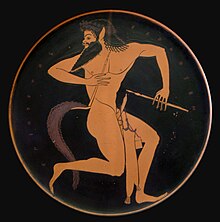What does satyrs mean?
Definitions for satyrs
satyrs
This dictionary definitions page includes all the possible meanings, example usage and translations of the word satyrs.
Did you actually mean satyric or satyriasis?
Wikipedia
satyrs
In Greek mythology, a satyr (Greek: σάτυρος, translit. sátyros, pronounced [sátyros]), also known as a silenus or silenos (Greek: σειληνός seilēnós [seːlɛːnós]), is a male nature spirit with ears and a tail resembling those of a horse, as well as a permanent, exaggerated erection. Early artistic representations sometimes include horse-like legs, but, by the sixth century BC, they were more often represented with human legs. Comically hideous, they have mane-like hair, bestial faces, and snub noses and are always shown naked. Satyrs were characterized by their ribaldry and were known as lovers of wine, music, dancing, and women. They were companions of the god Dionysus and were believed to inhabit remote locales, such as woodlands, mountains, and pastures. They often attempted to seduce or rape nymphs and mortal women alike, usually with little success. They are sometimes shown masturbating or engaging in bestiality. In classical Athens, satyrs made up the chorus in a genre of play known as a "satyr play", which was a parody of tragedy and known for its bawdy and obscene humor. The only complete surviving play of this genre is Cyclops by Euripides, although a significant portion of Sophocles's Ichneutae has also survived. In mythology, the satyr Marsyas is said to have challenged the god Apollo to a musical contest and been flayed alive for his hubris. Though superficially ridiculous, satyrs were also thought to possess useful knowledge, if they could be coaxed into revealing it. The satyr Silenus was the tutor of the young Dionysus and a story from Ionia told of a silenos who gave sound advice when captured. Over the course of Greek history, satyrs gradually became portrayed as more human and less bestial. They also began to acquire goat-like characteristics in some depictions as a result of conflation with the Pans, plural forms of the god Pan with the legs and horns of goats. The Romans identified satyrs with their native nature spirits, fauns. Eventually the distinction between the two was lost entirely. Since the Renaissance, satyrs have been most often represented with the legs and horns of goats. Representations of satyrs cavorting with nymphs have been common in western art, with many famous artists creating works on the theme. Since the beginning of the twentieth century, satyrs have generally lost much of their characteristic obscenity, becoming more tame and domestic figures. They commonly appear in works of fantasy and children's literature, in which they are most often referred to as "fauns".
The Nuttall Encyclopedia
Satyrs
in the Greek mythology semi-animal woodland deities who roamed the hills generally in the train of Dionysus (q. v.), dancing to rustic music; represented with long pointed ears, flat noses, short horns, and a hair-clad man's body, with the legs and hoofs of a goat; they are of lustful nature, and fond of sensual pleasure generally.
Mythology
Satyrs
(Sat′yrs). Spirits of the woodland, half men, half goats, and fond of wine and women. They were the attendants of Dionysus, and were similar in most respects to the fauns who attended Pan.
“Five satyrs of the woodland sort. . . . . . . With asses’ hoofs, great goggle eyes, And double chins of monstrous size.” (Yalden.)
Anagrams for satyrs »
strays
Numerology
Chaldean Numerology
The numerical value of satyrs in Chaldean Numerology is: 5
Pythagorean Numerology
The numerical value of satyrs in Pythagorean Numerology is: 3
Popularity rank by frequency of use
Translations for satyrs
From our Multilingual Translation Dictionary
- sátirosPortuguese
Get even more translations for satyrs »
Translation
Find a translation for the satyrs definition in other languages:
Select another language:
- - Select -
- 简体中文 (Chinese - Simplified)
- 繁體中文 (Chinese - Traditional)
- Español (Spanish)
- Esperanto (Esperanto)
- 日本語 (Japanese)
- Português (Portuguese)
- Deutsch (German)
- العربية (Arabic)
- Français (French)
- Русский (Russian)
- ಕನ್ನಡ (Kannada)
- 한국어 (Korean)
- עברית (Hebrew)
- Gaeilge (Irish)
- Українська (Ukrainian)
- اردو (Urdu)
- Magyar (Hungarian)
- मानक हिन्दी (Hindi)
- Indonesia (Indonesian)
- Italiano (Italian)
- தமிழ் (Tamil)
- Türkçe (Turkish)
- తెలుగు (Telugu)
- ภาษาไทย (Thai)
- Tiếng Việt (Vietnamese)
- Čeština (Czech)
- Polski (Polish)
- Bahasa Indonesia (Indonesian)
- Românește (Romanian)
- Nederlands (Dutch)
- Ελληνικά (Greek)
- Latinum (Latin)
- Svenska (Swedish)
- Dansk (Danish)
- Suomi (Finnish)
- فارسی (Persian)
- ייִדיש (Yiddish)
- հայերեն (Armenian)
- Norsk (Norwegian)
- English (English)
Word of the Day
Would you like us to send you a FREE new word definition delivered to your inbox daily?
Citation
Use the citation below to add this definition to your bibliography:
Style:MLAChicagoAPA
"satyrs." Definitions.net. STANDS4 LLC, 2024. Web. 26 Apr. 2024. <https://www.definitions.net/definition/satyrs>.



Discuss these satyrs definitions with the community:
Report Comment
We're doing our best to make sure our content is useful, accurate and safe.
If by any chance you spot an inappropriate comment while navigating through our website please use this form to let us know, and we'll take care of it shortly.
Attachment
You need to be logged in to favorite.
Log In